SELECTION OF QUESTIONS AND ANSWERS
OCTOBER 1999 PART 2
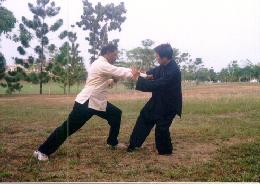
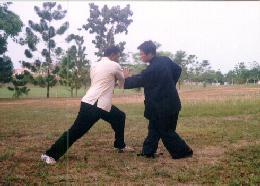
Combat Application of Taijiquan. As Mogan attacks Sifu Wong with a thrust punch, Sifu Wong rotates his body to his right into a Unicorm Stance, and simultaneously deflect the punch with his left hand.
Question 1
I have come to Tai Chi Chuan reasonably late in life as a result of seeking relief from painful sciatica. Over the past two years the sciatica has, dare I say, disappeared, my weight has reduced, vitality increased and I have regained the spirit of the searcher that I had some years ago.
— Jon, UK
Answer
This is wonderful. Carry on with your practice.
Question 2
I had the opportunity to meet William C.C. Chen. That in itself was a remarkable experience. He talked amongst other things of his hope that the more youthful among us would have the opportunity and technology now to develop Tai Chi Chuan further. He indicated that his teacher, Grandmaster Cheng Man-Ching, was able to do only what was possible in his lifetime and that the same was true for himself. 'How does each move in the form affect us?' 'What organ of the body is being affected?' 'With the exchange of information (via the internet?) these questions might well be answered.'
Answer
Sifu William C.C. Chen is a world renown master, and his views are invaluable. However, my views concerning what is mentioned above are quite different from his.
It will be great if the more youthful today could develop Tai Chi Chuan further, but that is, unfortunately, only a wish. Given the real situation today, the reverse is the case. Even the most optimistic cannot deny the fact that the quality of Tai Chi Chuan today is so very far below that in the past, say a hundred years ago.
If we really care for Tai Chi Chuan, and care for humankind who will benefit from Tai Chi Chuan, the immediate task is to prevent genuine Tai Chi Chuan from disappearing totally from the world. This could happen within three generations if the present plunging decline of Tai Chi Chuan is not checked. Tai Chi Chuan is an internal martial art, but there is nothing internal nor martial in what is being practised by the great majority of modern Tai Chi practitioners.I also disagree with the types of questions Sifu Chen suggested Tai Chi Chuan practitioners or researchers should ask. 'How does each move in the form affect us?' and 'What organ of the body is being affected?' are, in my opinion, comparatively not important. These questions were also not important in the past amongst Tai Chi Chuan masters. Had they been important the masters would have given us some answers.
What are more important are questions like “How should we practise so that Tai Chi Chuan will give us health and vitality?”, and “How effective, from actual experience, is the practise of Tai Chi Chuan in preventing or overcoming so-called incurable diseases threatening the world today?”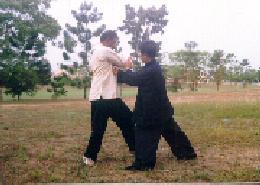
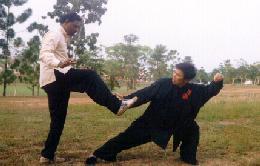
Instantly Sifu Wong moves forward his left leg into a left Bow-Arrow Stance and strikes Mogan's ribs with a cup-fist, in the Taijiquan pattern “Watching Fist Below Sleeves”. Mogan moves back his left leg a small step and simultaneously kicks at Sifu Wong's groin with his right leg. Sifu Wong quickly moves his left leg backward into the Taijiquan pattern “Low single Whip” to avoid the kick.
Question 3
Over the last 40 years Sifu Chen's research has led him to develop and expound his own particular style; subtle different from that of Professor Cheng and it was that which prompted the question. My current understanding of the form (Wudang in my case) is similar to that of a given text. Similar for example to the text of a Shakespeare play. The words and phrases, the moves have been written down for the actor or player to follow and interpret. Interpret and express, but not to change. To change it would be to adulterate, to diminish and reduce the potency of the art.
Answer
I agree with your perspective, and your analogy between a Tai Chi Chuan form and a Shakespeare play is illuminating. When we learn a Tai Chi Chuan form we are inheriting a legacy, a crystallization of centuries of development by masters. It is not only vain-glorious but utterly foolish for someone to imagine himself smarter than all the past masters, and change what the masters have traditionally taught.
This of course does not mean that we follow blindly or rigidly what has been passed down to us. We may modify when necessary for our particular needs or situations. This in fact was how, and why, the original Wudang Tai Chi Chuan evolved into different styles. The modification, if any, must be done by a master, like Sifu William Chen, who knows what he is doing and why he makes the modification; others, even senior students, would not be knowledgeable or skilful enough for the task.
Question 4
And yet, over the history of Tai Chi developments have taken place. We stand at the edge of a new millennium and in one sense we are the same as those who stood at the edge of previous millennia and yet we are different. Time has moved on. Is the Tai Chi we practise today out of date in some way? Should we be open to new influences?
Answer
The developments in Tai Chi Chuan, as in other kungfu styles, are the result of collective effort over a long period. Individual masters made modifications to their art for specific reasons. Some modifications were similar, others different. But all these are modifications, not drastic changes, and they maintained the basic philosophy and established practice of Tai Chi Chuan.
If certain movements to develop internal force were not suitable for their students, for example, their masters might use other movements, but they would not ask their students to use weights, which would have drastically change the development of force through chi to that through muscles.
Many of these modifications, even though they might be useful for particular exponents at their times, were soon forgotten once they outgrew their usefulness. Only those that passed the test of time are passed down to us as a legacy. Hence, the Tai Chi Chuan we practise today is not out of date; it is the logical result of continued development in line with changing times.
We have been open to new influences, and we have benefited. Printed books, for example, were a new invention that greatly benefitted (and still continues to benefit) many Tai Chi Chuan masters. The invention of firearms irreversibly altered the course of Tai Chi Chuan and other styles of kungfu. In our times, the internet, as you or Sifu Chen have mentioned, has enabled an exchange of information that was unheard of before.
But we must not be so carried away by modern innovations that we loose track of our continued tradition. We should not, for example, smother ourselves with theoretical information via the internect but neglect our daily practice, nor push western anatomical knowledge into Tai Chi Chuan where its conceptual framework is based on energy and mind.
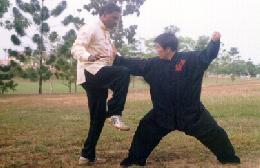
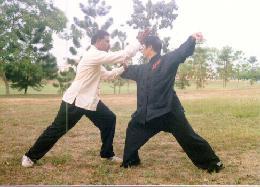
As soon as the kick is spent, and even before Mogan could retreat his kicking leg completely, Sifu Wong moves forward his body, without moving his legs, to strike Mogan's solar plexus with his right palm. Mogan moves his right leg backward to a left Bow-Arrow Stance and at the same time strikes Sifu Wong's head with his right palm.
Question 5
Each morning as I practise my Chi Kung and Form in the park I feel subtle differences. It's a wonder, and that in itself is the wonder that Lao Tzu spoke of in miracles manifest. I have found Tai Chi to be an extraordinary art that connects one time and time again to the source. How do you see this art evolving and developing?
Answer
What you experienced were the wonderful manifestations of “qi” and “shen”, or energy and spirit. Because Western culture does not have the concepts of energy and spirit to the extent and depth they are found in Eastern culture, most Westerners would be unable to understand and appreciate such experiences.
In chi kung and Tai Chi Chuan terms, you have expanded your energy, and uplifted your spirit. If you attempted to relate your experiences of energy and spirit to their effects on your muscles or organs, you would be out of key, or below par. In the Eastern concepts of “jing”, “qi” and “shen” — or matter, energy and spirit — muscles and organs belong to the category of “jing”.
If you view health in terms of harmonious energy flow, which is the fundamental tenet in most Eastern medical thought, especially the Chinese, and not in terms of muscles and organs working in mechanical precision, you would understand why your chi kung and Tai Chi Chuan practice has overcome your painful sciatica, improved your weight and increased your vitality.
If you appreciate that chi kung and Tai Chi Chuan work on the spirit, and not just on muscles and organs, you would understand why you have regained the spirit of youthfulness. If you understand that the highest level of Tai Chi Chuan attainment is “returning spirit to the Great Void” — which in Christian terms would be “returning to God's Kingdom” — you would understand why your practice connects you time and again to the Source.I am an idealist and optimist, but I am seasoned enough to say that Tai Chi Chuan today is degrading downhill — and fast. You and others who appreciate such a discussion on Tai Chi Chuan belong to a very privileged few. Many others might think I tried to mystify Tai Chi Chuan, considered by them as nothing more than some gentle exercise to loosen muscles and joints.
The enormous task facing Tai Chi Chuan practitioners today as they stand at the edge of a new millennium is not trying for new heights — they simply lack the skills and knowledge to do so — but attempting to redeem some glory from the past.
Please do not be mistaken that I am a backslider. Years ago when I was still in school, I thought how retrogressive Confucius was, always praising the golden age of the past. Like a typical youth schooled in Western philosophy, I stressed that we should look towards the future and march ahead — without fear and without hesitation. Only much later, when I had been more tempered with experience, I realized how naïve I was, and how profound was Confucius' teaching.Yet, Tai Chi Chuan, despite its degradation, holds much benefit for modern societies. Even as a dance, Tai Chi brings much needed relaxation and recreation to modern city dwellers. For the very few who have the opportunity to practise genuine Tai Chi Chuan, it brings besides combat efficiency, health and vitality, and spiritual joy.
Question 6
I am very interested in materials about Shaolin training in general — not just Kung Fu, but philosophy, life, training, etc. I wonder if you have any suggestions.
— Peter, USA
Answer
If you are thinking of the training in the Shaolin Monastery today, the best course is to go to the monastery yourself and experience it, or if you cannot experience it directly, at least observe it and learn from the masters there.
If you are thinking of traditional Shaolin training as it was done in the past, there are two main sources from where you can obtain reliable information — apart from the present day Shaolin Monastery which still keeps authentic records. The first is from people, preferably masters, who have inherited this tradition. The second source is from written records describing this tradition.
I happen to have inherited the Shaolin tradition, and it also coincides with what is described in written records. I shall very briefly describe this tradition to you.
Have no illusion about it — Shaolin training is very, very hard, and it is also very, very rewarding. For example, I had to practise the Horse-Riding Stance every day for months. When compared to what kungfu monks did in the monastery, this was a short time. My master took just a few minutes to teach me Cosmos Breathing, then he left me to practise it for over a year.
It is certain that those who have no self discipline, cannot progress much in traditional Shaolin training. What I got from such training was not just solid stances and internal force, but also tolerance, patience and perseverance, and more significantly a direct awareness of my energy and mind.
The Shaolin tradition is extremely rich in training methods. A Shaolin master will choose the best methods from his rich repertoire to meet the particular abilities and needs of individual students. But irrespective of the methods chosen, the training develops all the three faculties of man, namely body, energy and mind — or, poorly translated into more familiar Western concepts, all his physical, emotional, mental and spiritual dimensions. Hence, chi kung and Zen (or meditation) are essential aspects of Shaolin training.
A Shaolin disciple lives life to the full, but he guards against extravagance. His kungfu training enables him to be alert and agile, his chi kung training gives him excellent health and vitality, and his Zen training makes him aware of every moment. His life philosophy is based on Mahayana Buddhist teaching, which emphasizes compassion and wisdom. The supreme aim is to attain the greatest achievement any being can ever attain, i.e. cosmic realization, called by different cultures as a return to God, or union with the Great Void, and in Zen terms as seeing your original face or realizing Buddha nature.
It is no surprise if many people, including those who practise various Shaolin arts today, have not heard or read about Shaolin philosophy, life or training described in this way. This is because such a tradition was elite, while much of the teaching today all over the world said to be Shaolin has been watered down. If you, for example, learn external Shaolin kungfu forms from someone who has spent his whole life doing only kungfu forms, or learn chi kung from someone who himself has no experience of energy flow, or learn meditation from someone who earlier learned it in a weekend seminar, your concept of Shaolin training will be vastly different. And if three months later you teach what you have learnt and call it Shaolin, the concept of your students will again be different.
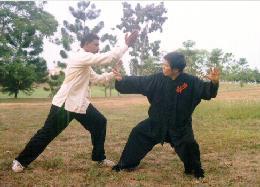
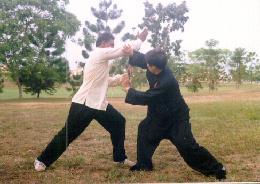
Immediately Sifu Wong moves his body backward, without moving his legs, to avoid Mogan's attack, then following the flowing momentum moves forward again, “floats” (but not block) Mogan's arm at the elbow, and simultaneously strikes Mogan's ribs with the left palm.
Question 7
I would like to ask how to make training equipments and weapons by ourselves, so we don't waste our money to buy imported ones. Can you teach us?
— Lit Jin, Malaysia
Answer
You may be surprised that in my kungfu training system most of the time — and for many students, all the time — we do not need any equipments and weapons. For example, while students in other kungfu schools use sandbags and weights to increase their power, we use chi kung exercises like “Pushing Mountains” and “Golden Bridge” to develop internal force. While others use cycling machines and chest expanders to increase stamina, we use chi kung exercises like “Lifting the Sky” and “Separating Water”. We find that our approach is not only convenient and economical, it is also more efficient as we can train our energy and mind, and not just our muscles.
Most of our students have no need of classical kungfu weapons because we are not keen in public demonstration, which is the main reason today why other students practise with weapons. When we wish to learn how to overcome an armed attacker, we use improvised weapons like a short stick representing a dagger, and a longer stick representing a sword. More advanced students may train with a staff, which is the most representative of Shaolin weapons, and it is quite easy to get a carpenter make one. When they progress to other long weapons like a spear, a trident or a Kwan-Tou (Big Knife), we improvise with the staff.
The weapons we improvise are meant only for our own training. If you need kungfu weapons for public demonstration, it is better to buy them than to make them yourself. You may make common training equipments yourself if you like. Sew or stitch some canvass together into a bag, fill it with coarse sand, and hang it on a sturdy branch to have a sandbag for your punching, kicking and other training. Wrap some canvass or rope round a pole, and strike your arm against it to strengthen your arms. Grip two bricks or some heavy objects for various types of weight training.
Question 8
I developed an autoimmune peripheral motor sensory neuropathy which only improved after starting and continuing prednisone. My condition seems worsened by stress and helped by the prednisone, but there are serious side effects from continuing prednisone. I have wondered whether you have had much success in helping people with autoimmune disease and in helping them get off immune suppressing drugs like prednisone?
— Dr Phillips, USA
Answer
I have some good success with people suffering from health problems similar to yours, although I have never tried to remember the technical names of their diseases. This is partly because the qigong approach is holistic. It would sound incredible to those used to the conventional medical paradigm, but it is true that in qigong it does not really matter what disease you are suffering, yet qigong would help you to overcome it. If you refer to my webpage Why you can eat your cake and chocolate, yet do not suffer from cardiovascular diseases? you would have some idea of the principles involved.
Another way of looking at the qigong paradigm is as follows. While conventional medicine works at different levels, such as those of the cells, tissues, organs or systems; qigong works at the most fundamental level, i.e. energy. Hence, conventional medicine has to deal with countless variables at the various levels that may cause sickness; but qigong deals with only one variable, i.e. whether qi flow is harmonious.
At the most basic unit of life, the cell, life is a meaningful exchange of energy. When your energy flow is harmonious, you will have good cells. When you have good cells, you will have good tissues. When your tissues are good, they form good organs. When your organs are good, your body systems work well. When your systems work well, you do not have illness.
From the qigong perspective, the names of various diseases are labels to describe certain symptoms showing that certain cells, tissues, organs or systems are not working properly. If some organs are not producing certain chemicals for the immune system, for example, conventional medicine may label the sickness as x, y or z. Interestingly, from the qigong perspective, we are not concerned with whether the sickness is called x, y or z; we are concerned with getting the energy to flow harmoniously. Once energy flow (or qi flow) is harmonious, that person will restore his health.
My students who have successfully overcome their illness through practising qigong do not have to continue taking medication, including immune suppressing drugs. If they still have to take medication, it cannot be said that they have overcome their illness.
Question 9
Are you aware of people being helped by changing external variables such as job, diet etc.?
Answer
Yes. If the illness is not severe, a change of external variables like job, diet and environment may help to overcome it. But if the illness is severe, such a change by itself, without medication, qigong or other healing methods, may be insufficient, although the change does contribute to the recovery.
In qigong, while jobs and environment are influential, diet is not important. In fact I advise my students to eat whatever they feel like eating. Their craving for certain food is nature's way of telling them to take the food for certain trace elements which his body may need.While moving into a more congenial job and environment is recommended, often it may not be feasible. Hence, if such a change is not crucial, students can remain at their jobs and environments while continuing with their qigong training. When they have become physically and emotionally healthier and fitter through qigong, they can adjust themselves to their jobs and environment which earlier they could not.
Question 10
For some time I have been thinking to get lessons in Shaolin Kungfu. I have gained much interest in Shaolin after seeing a television documentary.
— Peter, USA
Answer
Practising Shaolin Kungfu is certainly more difficult and less glamorous than what you would imagine it to be from a television documentary.
I am not sure whether what you saw was modern wushu or traditional kungfu, but both are very demanding in their training.
Question 11
However I am not sure if I have the ability to do so. Usually people start at a young age but I am already 28 years old.
Answer
What you said may apply to modern wushu. If you are thinking of modern wushu for public demonstration, learning it when you are a child, when your limbs are naturally flexible, is a great advantage. But you still can be a good wushu demonstrator if you learn it at 28 years old, although for some reasons most of the world's wushu demonstrators today are below 25.
Nevertheless, if you are not worried about performing in public but just like to learn wushu for elegance and fitness, or to teach others, you can have a rewarding wushu career from 28 to 48. It may be difficult to excel in modern wushu after 50.But the situation in Shaolin Kungfu is different. Many people, especially those who themselves have not practised Shaolin Kungfu, think that it is best to start young. Starting young is advantageous if we compare one starting kungfu at 5 and continuing to 90, with another person starting at 28 and continuing to 90.
But when we compare the benefits of a 5-year old and of a 28-year old when they start to learn Shaolin Kungfu at 5 and at 28 respectively, the older person will be much better of. What a child learns is usually the physical forms of Shaolin Kungfu; he is too immature to handle other aspects like kungfu philosophy, internal force and mind training. When they spar, a 5-year child will be nowhere compared with a 28-year adult.28 is a good age to learn Shaolin Kungfu. Even if you take 20 years to master it, you still have 40 years to enjoy your effort. I am of course talking about genuine Shaolin Kungfu, not Shaolin dance or Shaolin gymnastics. If you have mastered genuine Shaolin Kungfu, when you are at 88 you would probably be healthier, fitter and more importantly happier than many people at 50.
Question 12
I found out that there is a Shaolin school in my neighbourhood. How do I know if this school teaches the real thing? What things do I have to pay attention to?
Answer
Easy. Define what you mean by “the real thing”, then measure what the students of the school have achieved with what you mean. For example, if you mean that you should be able to perform some beautiful Shaolin forms, and the students there can do that, then the school is teaching “the real thing” you are looking for.
To me “the real things”, with regard to Shaolin Kungfu, includes two dimensions, namely forms and benefits. Hence a school is teaching “the real thing” if it teaches forms that have been established as typically Shaolin, and the students get benefits like combat efficiency, internal force and spiritual cultivation which are also established benefits that Shaolin Kungfu training will give.
For example, if I find that the students of the school is combat efficient but they use kickboxing instead of typical Shaolin kungfu forms, then, according to my definition, that school is not teaching the real thing. Alternatively, if I find that the forms are established Shaolin forms, but the students are not combat efficient with the Shaolin forms, then I also conclude that it is not the real thing.
If someone can use typical Shaolin forms for combat efficiency, I would call it the real thing, but at a low level. If he can use typical Shaolin forms for effective combat, and also for internal force training, I would call it middle level Shaolin. If he can use typical Shaolin forms for combat efficiency, internal force and spiritual cultivation, I would call it high level Shaolin. But please remember that this is only my interpretation of what the real thing is. Other masters may interpret differently.
